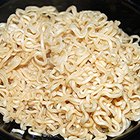
Pasta frequently sticks together during cooking because its outer edges turn into a glue-like starch when they are immersed in hot water. The problem is more pronounced with lasagna noodles, as they have more surface area than other pastas. Because the larger surfaces don't let the water circulate as well as with other types of pasta, use a large-enough pot and stir the lasagna noodles constantly during the first few minutes of cooking. This helps set the outer starches so they are less likely to stick. Adding a little vegetable or olive oil to the water also helps by creating a slippery film between the noodles.
Step 1
Fill the large pot with water and set over high heat. Add salt, if desired, or omit. Bring the water to a full rolling boil and add a good splash of the vegetable or olive oil.
Step 2
Put the lasagna noodles in all at once and stir them around with the spoon or the chopstick to keep them separate until the water returns to a boil. Keep stirring until the noodles start to soften slightly.
Step 3
Keep the water boiling just enough to prevent boil-overs, as any reduction in heat will turn the lasagna noodles mushy. Cook the lasagna noodles for 8 to 10 minutes, or to the al dente stage, when they are pliable but still chewy.
Step 4
Drain the lasagna noodles in the colander and place them singly on dry kitchen towels. Allow the noodles to cool slightly before proceeding with your recipe to make them easier to handle when assembling the dish.
Related Articles

Cooking Dried Banh Pho Noodles

How to Cook Penne Rigate Noodles in the ...

How to Cook Luglug Cornstarch Noodles

How to Improve Jar Spaghetti Sauce With ...

How to Make Fried Ramen Noodles

How to Make Toasted Bread Sticks With ...

How to Store Brussels Sprouts

How to Replace Flour With Oat Flour

How to Preserve Sauerkraut

Using a Convection Oven to Cook ...

How to Cook Trevally

How Fast Does Cooked Spaghetti Squash ...

How to Freeze Empanadas

How Long Does It Take to Cook Linguine?

How to Substitute Potato Starch for ...

How to Make Tomato Bruschetta

How to Cook Hu Tieu Noodles

How to cook bean sprouts

How to Make Hair Extensions Wavy

How to Substitute Mayonnaise for Sour ...
References
Tips
- Precooking the lasagna noodles before assembling the final dish is standard for baked lasagna. While you can use no-boil lasagna noodles, some recipes call for uncooked regular noodles. Such recipes generally include more wet ingredients, such as extra sauce or sliced tomatoes, which release more liquid during baking. The lasagna noodles are completely submerged in the sauce, and the casserole is also usually covered during baking to make the most of the steam created by the wet ingredients.
- If some of the lasagna noodles break while you are transferring them, use the odd pieces to patch up any gaps in the final dish. Be sure to fit the noodles to the pan so that no ends are left hanging over the edges, as these can burn or turn brittle during baking.
Writer Bio
Rachel Lovejoy has been writing professionally since 1990 and currently writes a weekly column entitled "From the Urban Wilderness" for the Journal Tribune in Biddeford, Maine, as well as short novellas for Amazon Kindle. Lovejoy graduated from the University of Southern Maine in 1996 with a Bachelor of Arts in English.
Photo Credits
Eising/Photodisc/Getty Images